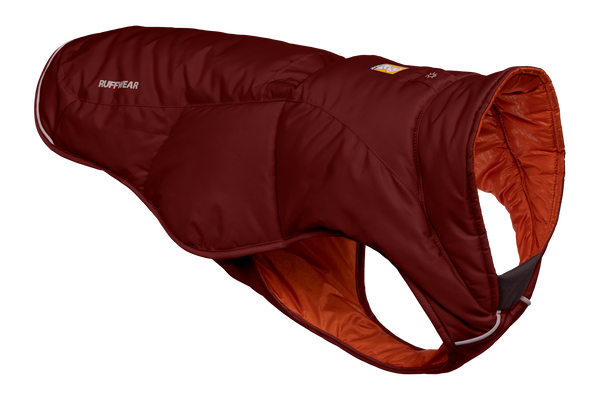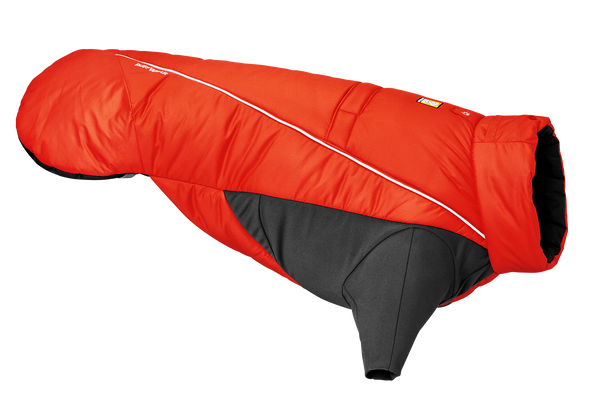Digging Into Our Environmental Pawprint: Supply Chain
A year ago, Kelly joined the Ruffwear pack as our Sustainability Coordinator. Her job? To discover the nitty-gritty details of our impact across our supply chain, and to recognize opportunities for reducing our environmental pawprint as a brand.
We checked in with Kelly to see what she’s learned in her first year. As Kelly explains, it’s an ever-evolving, always-room-to-improve process with numerous factors involved.
Today, we’ll look at Ruffwear’s efforts in establishing an environmentally-conscious supply chain. But stay tuned - we’ll continue to dive in and share more about other facets of our mission to conduct our business in a manner that in every way possible supports the community and protects the environment.

Q: What’s the main motivation for what you do in your role as a Sustainability Coordinator?
Lucky for me, Ruffwear has been conscientious of environmental stewardship for many years. Sustainability principles are built into the core values of the business.
As a company dedicated to making great gear, our definition of success includes embracing our responsibility to our community and to our planet - conducting our business in a way that maximizes the good we can do in the world while being mindful of the impact we have on the planet.
In order to do that, we need to gain visibility into all the ways - big and little - that doing business as Ruffwear leaves a mark, or what we’re calling our ‘pawprint’.
Q: What types of things factor into our pawprint?
There’s not a single thing that doesn’t! That’s why I have a job!!
‘Sustainability’, in terms of a business, is a big umbrella term for all actions (or inactions) resulting from the company doing business that can and will have an impact on people, the environment, and even the global climate.
And there’s always going to be room to improve. All of the following things factor into our pawprint:
- Supply Chain/Production:
- Material sourcing
- Chemicals management
- Inventory management of materials
- Agility & factory scheduling of final products
- Design & Development
- Material selection
- Field testing
- Product life cycle impacts
- Product packaging
- Distribution
- Inventory management of final, packaged products
- Transport methods
- Office Operations
- Including travel/commute methods
Q: Sounds like a lot to take on at once.
It is. And all those things are on our radar, but my focus since I came on board has been on the area that holds the most potential for reducing impact - the supply chain.

Q: What is a supply chain? What effect can it have on the environment?
A supply chain, is a complex network of suppliers that each source chemical, raw, and finished materials for what eventually becomes the final product. Our supply chain is concentrated in SE Asia, but let’s take a look at the complexity behind that rather simple statement.
A single product may have upwards of 20 individual material components, sourced from different suppliers. And those suppliers source their raw materials and chemical products from other suppliers further upstream, and so on and so forth - all the way down to fossil fuel extractors and raw chemical synthesizers.
One product, therefore, might have over 100 individual suppliers in its supply chain (or, “supply chain network”).
With about 100 in-line products - that’s likely more than 1,000 suppliers in our brand’s supply chain network, even with as much overlap in suppliers as possible.
Some companies look no further than the supplier named on the invoice for materials and finished goods, but every single supplier in a supply chain network is a point of impact.
Local ecosystems could suffer grave consequences if environmentally-conscious choices are not being made at these points of impact. Depletion of natural resources, mishandling of waste and mismanagement of emissions being the big ones.
Q: So how do we know if our entire supply chain network is environmentally-conscious?
Well, simply put: we don’t… yet. We’d need to know where every molecule of our products comes from, verifying the operations of each manufacturing facility along the way.
That’s a big ask, but that’s the challenge we’ve given to ourselves.
Q: Where do you start?
Our current approach involves a map of our supply chain network, a Restricted Substances List, and a Code of Conduct.
The mapping step requires becoming a detective and little by little pinpointing each supplier within the network. A supplier isn’t fully “mapped” until we have a factory address, headquarters address, primary materials/products sourced, and primary contact name/email/phone.
All of Ruffwear’s Tier 1 suppliers - or, factory partners who make our final products - are very well known to us and were easy to map. Most have been factory partners with Ruffwear for many years and have developed much more than just a customer-supplier relationship. We invest in their businesses just as they do ours.
At Tier 2 are the components suppliers to our Tier 1 supplier. Because every single component impacts the quality and performance of our gear, we vet and choose a vast majority of the components (aka “nominating” those components). This is a bit of a unique practice for a brand our size and our growth trajectory, but because of it, we have a real leg up for mapping our Tier 2 suppliers (not to mention, a great track record of quality products!).
Once we finish with Tier 2, we’ll move on to Tier 3 - the suppliers to the Tier 2 suppliers.

Q: What’s the benefit of having everything mapped out?
Visibility is invaluable. It helps us to see where we might be able to consolidate our active list of suppliers (fewer to manage means that we can get more in-depth with each one). And it highlights areas where our supply chain might be at risk.
It also gives us the opportunity to implement our Restricted Substance List (RSL) and Code of Conduct (CoC) further upstream in our supply chain, laying the foundation for two of our most influential initiatives within our greater sustainability program: chemicals management and social responsibility.
The RSL outlines all potentially hazardous chemicals we either prohibit from our supply chain altogether or restrict to a very conservative limit. It gives our suppliers an overview of our company beliefs in terms of chemicals management practices and expectations from them as a key partner.
Our CoC informs our suppliers of our expectations in terms of how their workers are treated, trained, and kept safe inside their manufacturing facilities.
Q: How is Ruffwear setting goals and measuring progress toward those goals?
I am really excited about two things right now that are helping with that: The Higg Index, and sourcing bluesign® approved materials.
The Higg Index is the sustainability measurement tool chosen and championed by the Outdoor Industry Association. Brands, retailers, and suppliers within the industry can benchmark their own sustainability journeys on an apples to apples basis with their peers.
The toolkit helps us move the needle in a positive direction with carefully constructed, data-supported modules to shine some light on areas of improvement, of missed opportunity, and on new avenues that haven’t yet been explored.
Once a company learns where they are through the Higg Index, it’s ON! It’s human nature to want to get better, be better, do better. We are turning to this tool to help us characterize our baseline year of 2019, set quantifiable goals for the future, and hold ourselves accountable to making continuous forward progress from a holistic perspective.
We see a lot of value in engaging in supplier relationships with facilities who have undergone a stringent certification process with bluesign® technologies. bluesign® assesses facilities for chemicals management competency, waste, and recycle stream proficiency - ensuring the materials coming out of those facilities are safe for the environment, workers, and you.

Our current count of products with at least one bluesign® approved component is over 30, but we’re improving upon that number during every design phase. While most of these materials are fabrics (like in our Clear Lake Blanket™, we also do business with a few bluesign® certified hardware/accessory partners.
With help from bluesign®, we’re working on our communication strategy for sharing with you which components those are in each product. Just like with the Higg Index, we’re setting our baseline with where we’re at in 2019 so we can set goals for where we’re going next.
Q: Any last comments as we wrap up this intro to our environmental pawprint and the supply chain?
Being transparent and truthful with you, our community of adventure seekers, is very important to us. Please continue to be curious and ask questions about what we’re doing to be environmentally mindful. We invite you to come along on this journey with us!


















